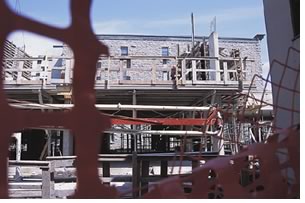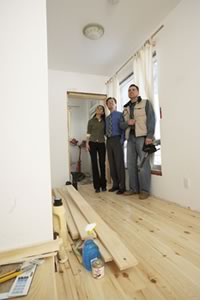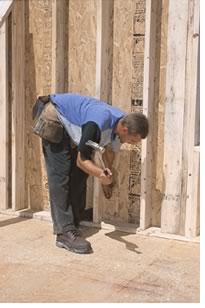

1/2006

by James B. Atkins, FAIA, and Grant A. Simpson, FAIA
The hallmark of successful project delivery is substantial completion. It is a milestone that can bring reward and satisfaction, or it can be the source of frustration and discord. It is sometimes elusive and difficult to achieve, can be complex, and is often viewed with very different expectations by members of the project team. Substantial completion is the brass ring for which everyone reaches; the Holy Grail that is diligently pursued. The projected date is typically written into the Owner-Contractor Agreement, and the Contractor’s Work Plan is prepared in anticipation of achieving it.
Substantial completion is defined in AIA Document A201-1997, General Conditions of the Contract for Construction, in Section 9.8.1, and in AIA Document G704-2000, Architect’s Certificate of Substantial Completion, as:
“the stage in the progress of the Work where the Work or designated portion is sufficiently complete in accordance with the Contract Documents so that the Owner can occupy or utilize the Work for its intended use.”
 This
date of reckoning defines the conditions that profoundly affect the risks
and rewards of the owner, the architect, and the contractor. It decides
when the owner will assume responsibility for operating and maintaining
the building. It starts the clock on the statutes of limitation and repose
for the architect’s liability. It initiates
the warranties by the contractor for certain building products and
systems, and it often determines obligations of the contractor for
a penalty resulting from late completion or a bonus for finishing early.
This
date of reckoning defines the conditions that profoundly affect the risks
and rewards of the owner, the architect, and the contractor. It decides
when the owner will assume responsibility for operating and maintaining
the building. It starts the clock on the statutes of limitation and repose
for the architect’s liability. It initiates
the warranties by the contractor for certain building products and
systems, and it often determines obligations of the contractor for
a penalty resulting from late completion or a bonus for finishing early.
It chronicles the projected end date of the architect’s basic services, which occurs 60 days after substantial completion; it bequeaths a substantial portion of retainage to the contractor; and, for owners and plaintiff’s lawyers, it supposes a representation of completeness by the design professional, which, if not essentially correct, can bring increased risk.
 When
vested interests of the players are pitted against one another, this
celebrated occasion can become a target-rich environment for mischievous
activities as the parties attempt to reconcile their cost of doing business.
Liquidated damage assessments, withheld payments, delayed guarantees,
and debated utility bills are but a few of the moves that are sometimes
made.
When
vested interests of the players are pitted against one another, this
celebrated occasion can become a target-rich environment for mischievous
activities as the parties attempt to reconcile their cost of doing business.
Liquidated damage assessments, withheld payments, delayed guarantees,
and debated utility bills are but a few of the moves that are sometimes
made.
Substantial completion is not an issue to be taken lightly. It is an occasion that demands accuracy, compliance, and fair dealing. It is an undertaking that brings risks, but it is likewise a process from which one can achieve deliverance. This article will explore the realities of substantial completion, the risks associated with it, the all-too-common challenges that accompany it, and the opportunities to guard against these risks and rise above the claims and financial penalties that are its occasional companions.
 A tale of two purposes
A tale of two purposes
It is understood in the design and construction industry that at least
one purpose of the certificate is to substantiate the point in time
when the building is nearly complete and available to be used. Less
obvious and less commonly discussed is the collateral purpose that
substantiates that the building is built nearly in accordance with
the contract documents. The contractor warrants in A201 in paragraph
3.5.1 that the project will be in accordance with the requirements
of the contract documents, but, in reality, no design can ever be exactly
matched by constructed fact. For this reason, a court or arbitrator
could reasonably construe Substantial Completion
to mean the building is not only substantially complete in terms of
physical quantity and utility, but also that it is substantially, but
not completely, in accordance with the contract documents for all material
purposes.
What is substantial completion?
AIA Document G704-2000, Architect’s Certificate of Substantial
Completion, offers some insight as to both the architect’s responsibility
and the definition of substantial completion. The first important duty
of the architect is:
“The Work performed under this Contract has been reviewed and found, to the Architect’s best knowledge, information and belief, to be substantially complete.”
As addressed in rogetsthesarus.com, synonyms for the adverb “substantially” convey the following meaning:
Substantially: essentially, largely, mainly …
Also, we have already seen that the definition of Substantial Completion contained within the language of the certificate involves a finding concerning the building condition as:
“…sufficiently complete in accordance with the Contract Documents so that the Owner can occupy or utilize the Work for its intended use.”
Once again, turning to Roget’s Thesaurus, the word “sufficiently” means: “adequately, acceptably, appropriately, well enough . . . ”
As used in the certificate, the words “substantially” and “sufficiently” are not intended to convey the meaning of absolute exactness but to convey the concept of almost being complete, and that the state of completion is materially so to the extent that the building can serve the intended use. The language in the certificate is not intended to convey that the building is either completely or precisely “in accordance with the contract documents.”
Construction observations and inspections
Because G704 functions as a companion to both AIA A201, General Conditions
of the Contract for Construction, and to the AIA Owner-Architect agreements,
the condition of “the architect’s knowledge, information
and belief” supporting the determination of substantial completion
is derived from the architect’s observations for general conformance
as well as from the first of only two “inspections” that
are performed by the architect. The Owner-Architect agreements generally
state:
“The Architect … shall visit the site at intervals appropriate to the stage of the Contractor’s operations … (1) to become generally familiar with … the progress and quality of the portion of the Work completed, (2) to endeavor to guard the Owner against defects and deficiencies in the Work, and (3) to determine in general if the Work is being performed in a manner indicating that the Work, when fully completed will be in accordance with the Contract Documents. However, the Architect shall not be required to make exhaustive or continuous on-site inspections to check the quality or quantity of the Work.” (Bold type added.)
This language makes it clear that the architect’s review of the work is made in anticipation of the completion of the project. As stated above, in addition to observations at the jobsite as construction is progressing, the architect conducts two inspections. The first is to determine the date of substantial completion so that a Certificate of Substantial Completion can be issued, and the second is to determine if the architect agrees with the contractor’s representation that the work has been completed.
 Contract documents
Contract documents
It is important to remember that “contract documents” are
a living and constantly changing body of information. Not only are contract
documents composed of the contracts, conditions, drawings, and specifications
that were originally issued, but they also include changes, supplementary
instructions, value analysis amendments, and other documents developed
during the construction process. All parties must recognize that clarification
documents such as requests for information, construction change directives,
and proposal requests can become contract documents if incorporated by
change order. Architect’s Supplemental Instructions and Change
Orders are contract documents by definition. On the other hand, when
documentation of changes in the contract is considered, the owner, contractor,
and design professionals must remain aware that shop drawings and submittals
are not contract documents. Making changes on shop drawings and submittals
will not incorporate the changes into the contract, except perhaps in
the limited condition where the architect adds comments regarding a contractor’s
specific request for a change, and the change does not involve a change
in time or cost. A contract change can only be accomplished by a contract
modification document as addressed in Article 7 of A201.
Profound realities
The issues associated with substantial completion can have a great effect
on all team players in both good and bad ways.
Implications for the contractor. The date of substantial completion is typically established at the onset of the project, and it is a milestone that the contractor is required by contract to achieve. The project schedule is predicated on this achievement, and the contractor’s work plan is formulated and managed to that end. If substantial completion is not achieved on the designated date, it can trigger damages if provided for in the contract. If the date should be in jeopardy, contractors frequently seek time extensions on the alleged basis of discrepancies in the construction documents and slow responses by the design professionals.
Contractor penalties and bonuses are often written into construction contracts in an effort to increase incentive for completion, and contractors and design professionals may not escape owner recovery efforts if penalties are assessed. Substantial completion is the affirming evidence that the completion date was or was not met.
 Substantial
completion also triggers payments to the contractors. When a project
reaches this milestone, it is customary to release all retainage except
for an amount that can safely cover the cost of work remaining for correction
or completion. In many cases, this remaining money equates to the contractors’ profit.
This occasion also allows the contractor to reassign team members to
other projects, leaving only a skeleton crew to complete the work and
administer closeout, thus reducing overhead and general conditions costs.
Substantial
completion also triggers payments to the contractors. When a project
reaches this milestone, it is customary to release all retainage except
for an amount that can safely cover the cost of work remaining for correction
or completion. In many cases, this remaining money equates to the contractors’ profit.
This occasion also allows the contractor to reassign team members to
other projects, leaving only a skeleton crew to complete the work and
administer closeout, thus reducing overhead and general conditions costs.
Implications for the architect. For the design professionals, substantial completion typically marks the beginning of the statutes of limitation and repose. The statute of limitation is the time that a claim can be legally made after the condition giving rise to the claim is first discovered. The statute of repose is the time within which discovery of such conditions will allow a claim to be made. Some states, such as Texas, have a 10-year statute of repose with a 2-year statute of limitation for professional negligence. This means that a claimant has 10 years to discover conditions and 2 years after discovery to take legal action. Therefore, for 12 years after substantial completion, the architect is exposed to potential claims for negligence.
Design professionals also have exposure to damages resulting from late completion of construction. It is common for owners and contractors to blame project delays on deficiencies in the drawings and specifications or slow responses, alleging that the substantial completion date was adversely affected by the design professional’s actions.
Some owners claim that the architect’s issuance of a Certificate of Substantial Completion is de facto approval of any remaining nonconforming work placed by the contractor. They often believe the architect is at fault, although the contract documents clearly state that the contractor is solely responsible. The contractor’s warranty to the architect and the owner that the work will be free of defects further reinforces their sole responsibility for work completion and conformance.
Accordingly, the owner’s occupancy or use of the project does not constitute acceptance of nonconforming work, as is succinctly stated in A201 in paragraphs 9.6.6 and 9.9.3.
Implications for the owner. Regarding substantial completion, the greatest damage experienced by owners is loss of use caused by a delayed opening. If project use produces revenue—such as a hotel, casino, professional sports facility, or hospital—damages can mount up quickly. Other damages from a delayed opening can be extended loan costs, increased operating costs due to maintaining two facilities, and labor burden costs for increased employees hired in anticipation of moving into the new facility.
Risk considerations
When administering substantial completion, architects should be mindful
of the inherent risks involved. Consider the following in your management
activities.
You do not control the date. When architects negotiate their services contracts, they typically apply a fee based on the prevailing market rate. The portion of their fee that is allocated for the construction phase is not based on the length of time required for construction unless the fee basis is time-driven. When a contractor comes on board, the construction time is typically negotiated in the construction contract with a projected date of substantial completion. The architect may be made aware of the contractor’s proposed completion date but is rarely consulted regarding the appropriateness of that date.
 Therefore,
it is advantageous to address substantial completion with the owner at
the beginning of the project to establish that your construction phase
services are finite. If you fail to do this, the owner will likely expect
you to provide construction phase services without additional compensation
for as long as the project continues. One way to control your risks in
this area is to stipulate a set number of site visits within your initial
fee and designate a cost per site visit for any in excess of the original
number. You will more likely be successful in achieving this if your
cost per visit is quoted on your direct and overhead cost without excessive
profit markup. This way, the owner will feel that you are being fair,
and you will be protected against uncontrolled losses caused by a time
for construction that you do not control.
Therefore,
it is advantageous to address substantial completion with the owner at
the beginning of the project to establish that your construction phase
services are finite. If you fail to do this, the owner will likely expect
you to provide construction phase services without additional compensation
for as long as the project continues. One way to control your risks in
this area is to stipulate a set number of site visits within your initial
fee and designate a cost per site visit for any in excess of the original
number. You will more likely be successful in achieving this if your
cost per visit is quoted on your direct and overhead cost without excessive
profit markup. This way, the owner will feel that you are being fair,
and you will be protected against uncontrolled losses caused by a time
for construction that you do not control.
The contractor’s proposed completion date may significantly differ from the date originally anticipated by the architect. And variables such as phased construction and adverse climatic conditions can greatly affect total construction time. It is good practice to compare the two dates to determine if additional construction phase fees are appropriate for accelerated services if the date is earlier or extended services if the date is later. The architect’s costs, just like the contractor’s, increase if too little or too much time is scheduled.
You are assessing work conformance. The AIA documents require the architect to determine general conformance of the work to the contract documents, but they do not require the architect to assess work quantity or completeness. The reason for this is that the contractor is responsible for putting the work in place and, therefore, they control the quantity. This is why architects do not issue a Certificate of Final Completion as a part of their services. To do so would constitute a representation by the architect that the work is 100 percent complete in every way, a condition that is warranted by the contractor and for which the contractor is solely responsible.
It is important, therefore, that design professionals use care in assessing work conformance and completion. We have addressed the importance of avoiding quantitative statements in field observation reports and other communications in our past article entitled, “Project Manager or Risk Manager?” There is no requirement contained in the AIA documents or in MasterSpec that requires the architect to quantify the work in place. However, certifications of contractor applications for payment are often inappropriately viewed by owners as a de facto representation of work-in-place quantities as well as work quality.
Your assessment is a certification. According to Black’s Law Dictionary, a certification is: “A formal assertion in writing of some fact.”
A fact, according to Black’s is: “An actual and absolute reality, as distinguished from mere supposition or opinion.”
 Therefore, certifications by a design professional can carry risks that
rise above your contracted responsibilities should you use improper
wording or misleading connotations. You should be aware of words to
avoid and stick with the recommendations provided in The
Architect’s
Handbook of Professional Practice and the wording suggested in the
AIA documents. You should consult legal counsel in all cases involving
certifications containing language that differs from the wording contained
in the AIA documents, or when otherwise prudent.
Therefore, certifications by a design professional can carry risks that
rise above your contracted responsibilities should you use improper
wording or misleading connotations. You should be aware of words to
avoid and stick with the recommendations provided in The
Architect’s
Handbook of Professional Practice and the wording suggested in the
AIA documents. You should consult legal counsel in all cases involving
certifications containing language that differs from the wording contained
in the AIA documents, or when otherwise prudent.
An example of a certification that is required in addition to what is prescribed in the AIA documents is when the project lender or title agency desires a certification from the architect. Such certifications often contain wording that goes beyond what the architect is obligated to do within their contract and within the accepted standard of care. The entities that seek this additional certification are typically not concerned with your level of risk exposure.
The owner and contractor may have conflicting priorities. Contradiction and complexity is sometimes introduced into the substantial completion process should the owner and the contractor have conflicting priorities. In the event there are liquated damages stipulated in the owner-contractor agreement, and the project is being completed late, the owner will want the substantial completion date to be later rather than sooner and the contractor will desire the opposite determination. This can result in a disputed date, so you should always thoroughly document your reasoning for the date you certify.
Even when penalties are not a part of completion, an owner may challenge the substantial completion date to delay paying for utility costs or tolling the beginning of warranties. The bottom line is that substantial completion is a milestone in the project delivery process that profoundly affects many parties and, as a result, often does not occur without disputes and extenuating circumstances.
 Your
certification may be taken literally. When certifying substantial
completion, it is easy, and even common, for the architect to view the
occasion as a routine event in the course of project delivery that requires
only a review of the punch list and a signature on a form. Unfortunately,
should the certification be scrutinized in a claim or litigation, it
may be evaluated only on its literal representation. If the certification
does not cite and quantify any nonconforming or incomplete work, such
as an attached punch list or log of nonconforming work, the courts may
assess that the architect has found the project to be substantially complete
in every way. Even though the most projects have some portion of their
scope that does not conform to the documents, if these portions are
significant, you could be adjudged to have misrepresented the state
of project completion.
Your
certification may be taken literally. When certifying substantial
completion, it is easy, and even common, for the architect to view the
occasion as a routine event in the course of project delivery that requires
only a review of the punch list and a signature on a form. Unfortunately,
should the certification be scrutinized in a claim or litigation, it
may be evaluated only on its literal representation. If the certification
does not cite and quantify any nonconforming or incomplete work, such
as an attached punch list or log of nonconforming work, the courts may
assess that the architect has found the project to be substantially complete
in every way. Even though the most projects have some portion of their
scope that does not conform to the documents, if these portions are
significant, you could be adjudged to have misrepresented the state
of project completion.
To effectively manage this dilemma, you should keep track of any nonconforming work you observe during the course of the construction phase. Nonconforming work can arise from contractor error, which the owner can accept, if they choose, or it can survive because the owner has accepted alternatives the architect does not agree with, both of which are allowed in A201 General Conditions of the Contract for Construction.
Disputes can also arise when you qualify owner-accepted nonconforming work in your certificate and the owner is not expecting it. Therefore, it is important to keep all parties advised when it is likely that the certificate will contain such qualifications. A review of actions to take regarding owner-accepted nonconforming work during project closeout is addressed in The Architect’s Handbook of Professional Practice—Update 2003, entitled “Effective Project Closeouts,” by Douglas C. Hartman, FAIA.
Completion challenges
Substantial completion, because of the myriad conflicting priorities
and objectives of the parties involved, can be a difficult experience.
The financial penalties and rewards that hang in the balance can cause
discord among the parties, and the issues involved, as noted below,
can be quite complex.
Liquidated damages. Most owners want to gain access to their project on the earliest possible date. Whether it be for their business operations or to allow their tenant contractor to start the interior build-out, they typically want the work finished and the contractor out. To achieve this end, they sometimes use financial incentives to coerce completion. Liquidated damages can be quantified in the Owner-Contractor Agreement. This is typically an amount of money charged per day for each day after substantial completion that the project is late. It is intended as an offset to owner costs for loss of use. Including such an amount in the contract avoids the process of trying to determine actual damages after the fact.
As you can imagine, the potential for liquidated damages can significantly motivate the contractor, however, the potential for making themselves financially whole also carries motivation for some owners. Unfortunately, the end result is often a dispute over the substantial completion date involving finger-pointing and a search for parties to blame.
 Separate
contractors. Another matter that sometimes complicates the picture
is separate contractors hired by the owner. They work on the project
at the same time and in the same location of the general contractor.
While A201 requires the general contractor to “cooperate” with
separate contractors, their presence provides an opportunity for the
general contractor to claim damages should they feel that the separate
contractors have interfered with their work.
Separate
contractors. Another matter that sometimes complicates the picture
is separate contractors hired by the owner. They work on the project
at the same time and in the same location of the general contractor.
While A201 requires the general contractor to “cooperate” with
separate contractors, their presence provides an opportunity for the
general contractor to claim damages should they feel that the separate
contractors have interfered with their work.
Early occupancy. Early occupancy of some portion of the project by the owner can present a common challenge to substantial completion. Whether it is because of the owner’s desire to perform separate work such as interior finish out or because of actual move-in, occupancy of the project before it is substantially finished requires careful coordination and documentation.
For example, if an owner occupies a building before the punch list has been completed, there will likely be disagreement between the owner and contractor over dents and scratches. In the case of separate contractors, there can be disputes over the completeness and acceptability of the work prior to being covered up or changed. It is advisable to discuss early project occupancy in advance with the owner to avoid misunderstandings and allow for appropriate coordination.
Punch list coordination. The completion of a project may not always be on time, and the final portion of work sometimes include compressed activities. Therefore, it is important that the contractor and architect coordinate with each other on the punch list review. Much time can be wasted if areas are not ready to punch when scheduled, and much money can be spent if a “SWAT team” is required for the design team to review substantial completion in an abbreviated time period.
 A
good general rule is that the design team should make two trips through
the building as part of basic services: one to determine what work remains
for completion or correction, and one to determine when that work has
been completed or corrected. It is important to remind the contractor
that additional trips will result in additional fees. These charges should
rightfully be invoiced to the owner; therefore the owner must be apprised
of any delay by the contractor and any resulting holdup in preparing
the punch list. The owner has the right in Section 12.2.1.1 of A201 to
withhold these additional service charges from the contractor’s
payment. The lack of a contractual relationship will prevent the architect
from submitting an invoice for additional services to the contractor.
Even in the absence of an invoice sent to the owner, the causes for delayed
or prolonged punch list activities should be documented.
A
good general rule is that the design team should make two trips through
the building as part of basic services: one to determine what work remains
for completion or correction, and one to determine when that work has
been completed or corrected. It is important to remind the contractor
that additional trips will result in additional fees. These charges should
rightfully be invoiced to the owner; therefore the owner must be apprised
of any delay by the contractor and any resulting holdup in preparing
the punch list. The owner has the right in Section 12.2.1.1 of A201 to
withhold these additional service charges from the contractor’s
payment. The lack of a contractual relationship will prevent the architect
from submitting an invoice for additional services to the contractor.
Even in the absence of an invoice sent to the owner, the causes for delayed
or prolonged punch list activities should be documented.
Contractor’s failure to complete or correct the work. Problems can arise should the contractor fail to complete or correct all of the work on the punch list in a timely manner. In addition to extra trips by the design professional to the building site, the owner may have to hire another contractor to finish the work, and the new contractor may not be able to complete the work as efficiently as the original contractor. Allowing for these additional costs is why money is often retained that is a greater amount than the determined value of the work remaining for completion or correction.
 A
significant problem arises when there
maybe no longer enough money remaining in the contract to pay for the
remaining uncompleted work. Contractors submit general conditions costs
with each application for payment, and if the project is delayed long
enough, the contract balance can erode to the point that there is more
work remaining to do than there is money to pay for it.
A
significant problem arises when there
maybe no longer enough money remaining in the contract to pay for the
remaining uncompleted work. Contractors submit general conditions costs
with each application for payment, and if the project is delayed long
enough, the contract balance can erode to the point that there is more
work remaining to do than there is money to pay for it.
Should this occur, the architect is empowered to withhold certification to protect the owner as stipulated in A201, Section 9.5, “Decisions to Withhold Certification,” which states:
“The Architect may also withhold a Certificate for Payment or, because of subsequently discovered evidence, may nullify the whole or a part of a Certificate for Payment previously issued, to such extent as may be necessary in the Architect’s opinion to protect the Owner from loss . . . because of . . . 6. reasonable evidence that the Work will not be completed within the Contract Time, and that the unpaid balance would not be adequate to cover actual or liquidated damages . . . ”
This section of A201 also allows for the withholding of a certification for other reasons, including defective work not remedied, damage to the Owner, and persistent failure to carry out the work. When a certification is withheld or a previous certification is nullified, it is generally appropriate to notify the contractor’s surety of your actions if the contractor is covered by a Performance and Payment Bond. The surety must give consent to final payment, and AIA Document G707-1994, Consent of Surety to Final Payment, is available for this purpose.
Withholding of a certification should not be approached lightly or casually. Because this condition usually results in the contractor having to work without receiving payment, it can result in the contractor’s refusal to work and the initiation of legal action. Therefore, this action should be taken only if absolutely necessary, and the reasons for taking it thoroughly documented. Project delays should be discussed with the affected parties as soon as they occur. A201 and the Owner-Contractor Agreements require that the contractor take necessary measures to get back on schedule, and if appropriate actions are taken, the withholding of a certification may be avoided.
 Consultant certifications
Consultant certifications
The architect’s consultants are required to “assist” the
architect in determining the date or dates of substantial completion
for their portion of the work. This is stipulated in Section 4.5.14 of
AIA Document C141-1997, Standard Form of Agreement
Between Architect and Consultant. AIA Document G704-2000, Architect’s
Certificate of Substantial Completion, is available for the architect
to document substantial completion of the entire project.
There are several options for documenting substantial completion by the architect’s consultants. Minimum efforts could include their signatures adjacent to the architect’s on Document G704. A more comprehensive approach could be to prepare a separate consultant’s certification and attach it to the architect’s certificate. In any case, written confirmation of their opinions and an actual certification is advisable. One architecture firm has prepared its own form entitled Consultant’s Certificate of Substantial Completion. It includes only the consultant’s signature and is attached to the architect’s certificate at the time of issuance.
A perfect world
There are times when substantial completion occurs on schedule and punch
list review time is reasonable. When substantial completion is successful,
it is usually because of a:
- Reasonable original project schedule
- Reasonable original contract sum
- Deliberate and adequate contractor’s work plan
- Capable team of trade contractors
- Stable and timely sequence of owner decisions
- Candid series of discussions among all parties
- Well-documented construction process
- Thorough and effective punch list schedule
- Commitment to adequate work quality
- Pre-planned closeout phase.
The beginning of the end
Thus, substantial completion can be both a curse and a cure. Although
substantial completion is a significant milestone of project delivery—the
anticipated beginning of the end of contract obligations—it is
often disputed and prone toward complexity. It is an event of conflicting
priorities for all involved. The contractor usually wants it earlier
rather than later. The owner often views it as later as regards costs
and warranties, although they desire it to be earlier so they can use
their building. The architect wants the date not to move, but it almost
always does. Money hangs in the balance, profits realized or denied.
It is the starting bell for money recovery attempts, and posturing
and michievous activities sometimes are a factor.
It is also the beginning of closeout activities. Testing, equipment start-up, operations training, and the plethora of record documentation are a part of making it down the home stretch. It is an event that can be successful and borderline enjoyable, provided that advance preparation and execution remain intact. When the project team is in sync and obligations are met, it can be a shining moment before the owner for both the contractor and designer.
When all goes as planned, it can be a time for pride and profit. The ribbon can be cut and the building dedicated, the project documents can be archived, and the job cost report can be finalized. Once again, the project manager can begin his or her next assignment. And when the Owner-Contractor Agreement is executed, substantial completion will again become the brass ring; the most anticipated and pursued milestone in the project schedule.
So grab your camera, clipboard, half-sized drawings, punch list, and tape recorder. Put on your hard hat and safety gear, and begin your substantial completion inspection.
Oh, and while you’re at it . . . don’t forget to be careful out there.
Copyright 2006 The American Institute of Architects.
All rights reserved. Home Page ![]()
![]()
This series will continue next month in AIArchitect when the subject will be “Gimme Shelter.” We will explore common exterior-wall mistakes made in the design and construction industry as well as the various causes of exterior-wall failures.
If you would like to ask Jim and Grant a risk or project management question or request them to address a particular topic, contact them via the AIA Risk Management office.
James B. Atkins, FAIA, is a principal with HKS in Dallas. He serves on the AIA Documents Committee and the AIA Risk Management Committee.
Grant A. Simpson, FAIA, manages project delivery for RTKL Associates in Dallas. He serves on the AIA’s Practice Management Advisory Group.
Their most recent AIArchitect article, “Lemons to Lemonade: Benefiting from Mistakes”, published in two parts in December 2005: Part I, Part II.
This article represents the informed opinion of the authors and does not necessarily reflect the position of the AIA. It is intended for general information purposes only and does not constitute legal advice. The reader should consult with legal counsel to determine how laws, suggestions and illustrations apply to specific situations.
![]()